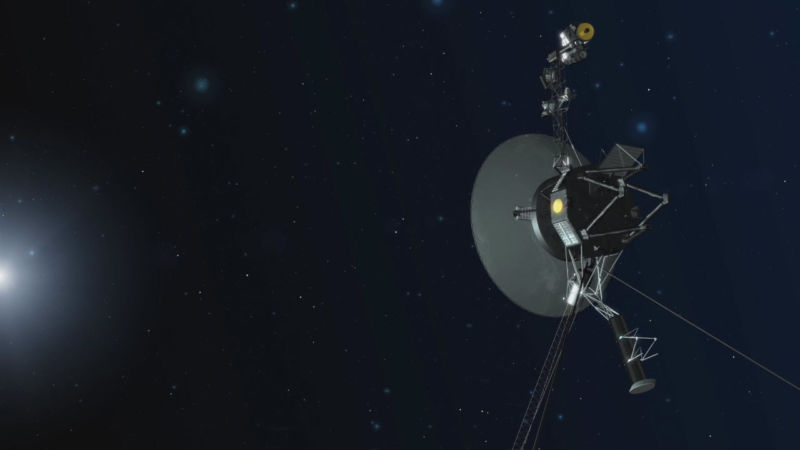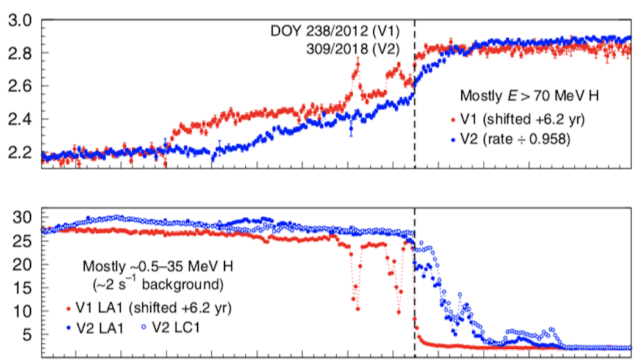Close to the edge –
Five papers detail what the edge of interstellar space looks like.

Enlarge/An artist’s interpretation of Voyager 2, pointed to transmit data to Earth.
People probably suspect that having no data is the worst frustration for scientists. In reality, having just a single source of data can be worse, since you don’t know how typical that lone example might be. But the worst situation is to have two sources of data that don’t entirely agree, leaving you with the challenge of trying to determine what causes the differences.
That situation is where the scientists who work with data from NASA’s Voyager probes find themselves in the wake of Voyager 2 reaching interstellar space last year, making it the second spacecraft we’ve built that has made it there. Now, in a series of five papers, researchers have attempted to compare or contrast the data from the two Voyagers and try to make sense of the contradictions, knowing that we’ve got nothing built that’s going to get new data from that distance any time
At the edge of the Solar System
The Sun’s gravitational influence extends out to the edge of the Oort cloud, over three light years from the Sun. But the Sun influences its environment in ways that go beyond simple gravity. It generates an enormous magnetic field that extends well beyond the planets and emits a stream of charged particles that stream out toward interstellar space. These influences are limited by the influence of our galaxy, which has its own magnetic field and an interstellar medium full of its own charged particles.
At some point, distant from the Sun, these two influences collide: the Sun’s influence weakens, and the galaxy takes over. There had been a number of theoretical ideas about how that transition takes place. But testing those ideas directly is obviously a real challenge, given that doing so requires sending hardware to the edge of the Solar System.
Conveniently, over 40 years ago, we happened to send some there. This was incidental; the Voyager probes were built to study the outer planets but were given gravitational boosts that ultimately sent them speeding off fast enough to cover three times the distance from the Earth to the Sun every year. Back in 2012 , this allowed Voyager 1 topass through the transition zoneand outside of the Sun’s influence.
During that transition, Voyager 1 saw a gradual increase of high-energy cosmic rays, but these were punctuated by two spikes where high -energy cosmic rays suddenly rose. These corresponded to two dips in the intensity of lower-energy charged particles from the Sun, suggesting that some of the interstellar medium was leaking into the Solar System. In each of those cases, the solar influence recovered, with cosmic rays dropping back onto their gradual trend and solar particles returning to their normal levels.
Then, suddenly, the solar particles dropped to nearly zero, while the cosmic rays reached a high level, where they have remained since . All of which indicated that Voyager had reached interstellar space.
A new transition
Voyager 2 has now gone through the same process of moving into interstellar space, but it had a somewhat different experience from its earlier sibling . For starters, as shown in blue below, the appearance of high-energy cosmic rays wasn’t punctuated by any of the sudden surges seen by Voyager 1. Similarly, levels of solar particles remained stable throughout its approach to the edge of the Solar System . And, rather than falling off a cliff when the probe reached interstellar space, solar particles continued to strike Voyager 2’s sensors for more than (days after the transition.)

Enlarge/While Voyager 1 (red) and 2 (blue) crossed the same boundary, there were differences between what the two saw there.
Another key difference is that Voyager 2 had a working solar-wind sensing instrument, which was non-functional on Voyager 1. The density of the solar wind is expected to thin out with distance from the Sun. Yet Voyager 2 found that wind increased in density as the probe approached the transition point and also became somewhat more energetic. This data suggests that the transition causes the solar wind to pile up against the boundary. Voyager 1 may have experienced the same thing but was unable to register it.
Still, a number of features seen by the two spacecraft were similar in outline if not in details. Voyager 1 hit the boundary at about 122 astronomical units from the Sun (an AU is the average distance from the Earth to the Sun); Voyager 2 hit it at 119 AU. Both probes observed a transition zone that was roughly eight AU across, although Voyager 1 saw an extended zone of low-velocity particles in this region. In both cases, the magnetic field didn’t change directions as the probes entered interstellar space, which was unexpected, given that the solar and galactic magnetic fields aren’t oriented the same. (Voyager 2 also saw a much stronger magnetic field.)
Managing conflicting information
So what can explain all these differences? One potential contributor is the solar cycles. Voyager 1 crossed the boundary at a low point in solar activity, which could mean that the boundary was pushing inward toward it. By contrast, Voyager 2 had to chase the edge of the solar influence at a time when solar activity was higher.
These differences highlight the more general explanation of why the transition experiences were different: the boundary represents an intersection between two dynamic fluids, with all the complicated interactions that that implies. To an extent, it would have been surprising if there weren’t some sort of differences.
But that doesn’t mean we wouldn’t like to know more. Unfortunately, the Voyagers’ contribution is probably done. The next structure that’s expected to exist is the bow shock, but that’s likely to be over 100 AU farther out. “We’ll reach it, but without any power to send anything back,” said JPL’sEdward Stoneat a press conference describing the studies. “Another five years or so, we won’t have enough power for any instruments.”
“When the two Voyagers were launched, the Space Age was only 20 years old, “Stone went on. “We didn’t know things could last for 40 years out there. “
New Horizons, the next-most-distant active mission, will run out of power at about 90 AU, so it won’t be able to report in when it reaches the boundary that the Voyagers have identified. An accompanying perspective suggests that Voyager 2 is going to be the last spacecraft to cross this boundary for at least 25 years. While there’s some talk of building a dedicated probe to cross a different part of the transition area, we’re likely to be left parsing the Voyager data for decades to come. It’s a fitting last hurrah for probes that spent much of the 1970 s and ’80 s defining planetary science.
The individual research articles can be reached fromthis webpage.







GIPHY App Key not set. Please check settings